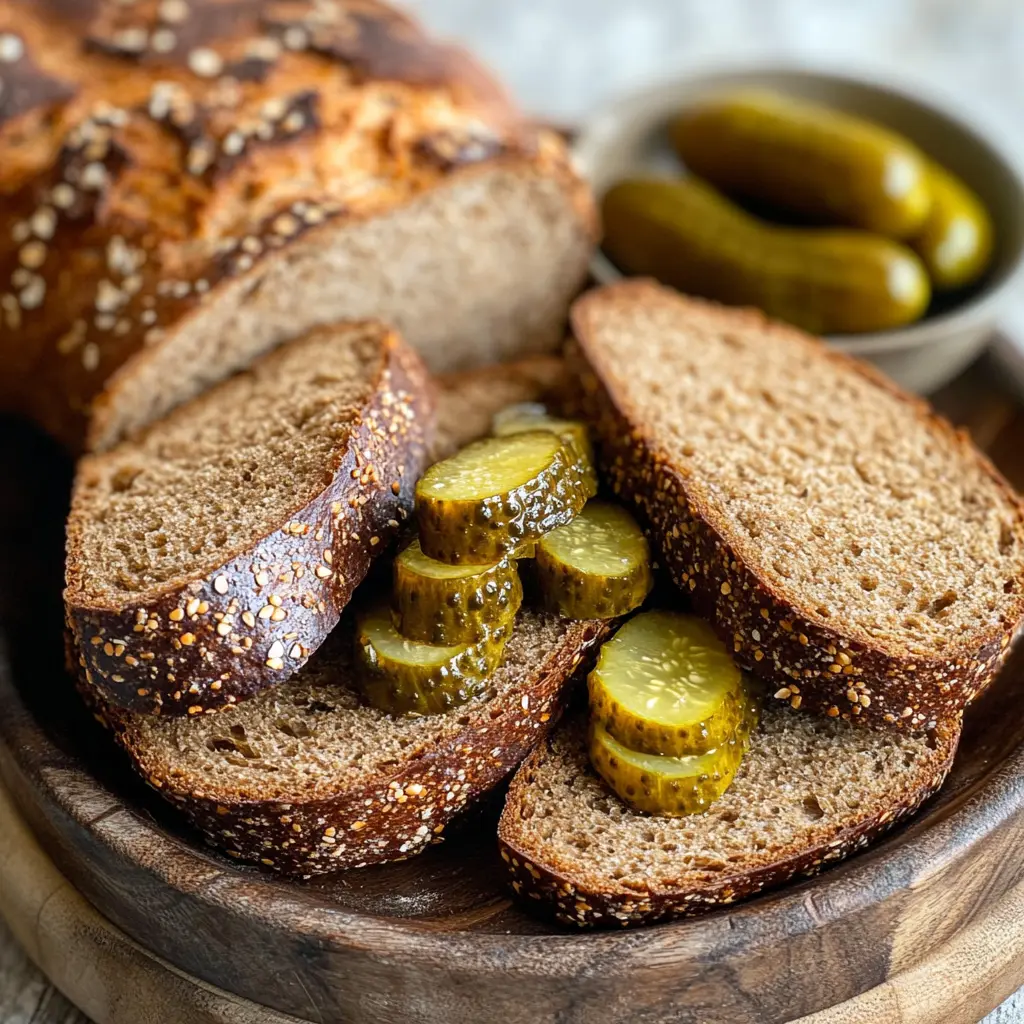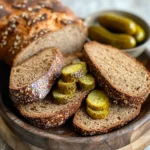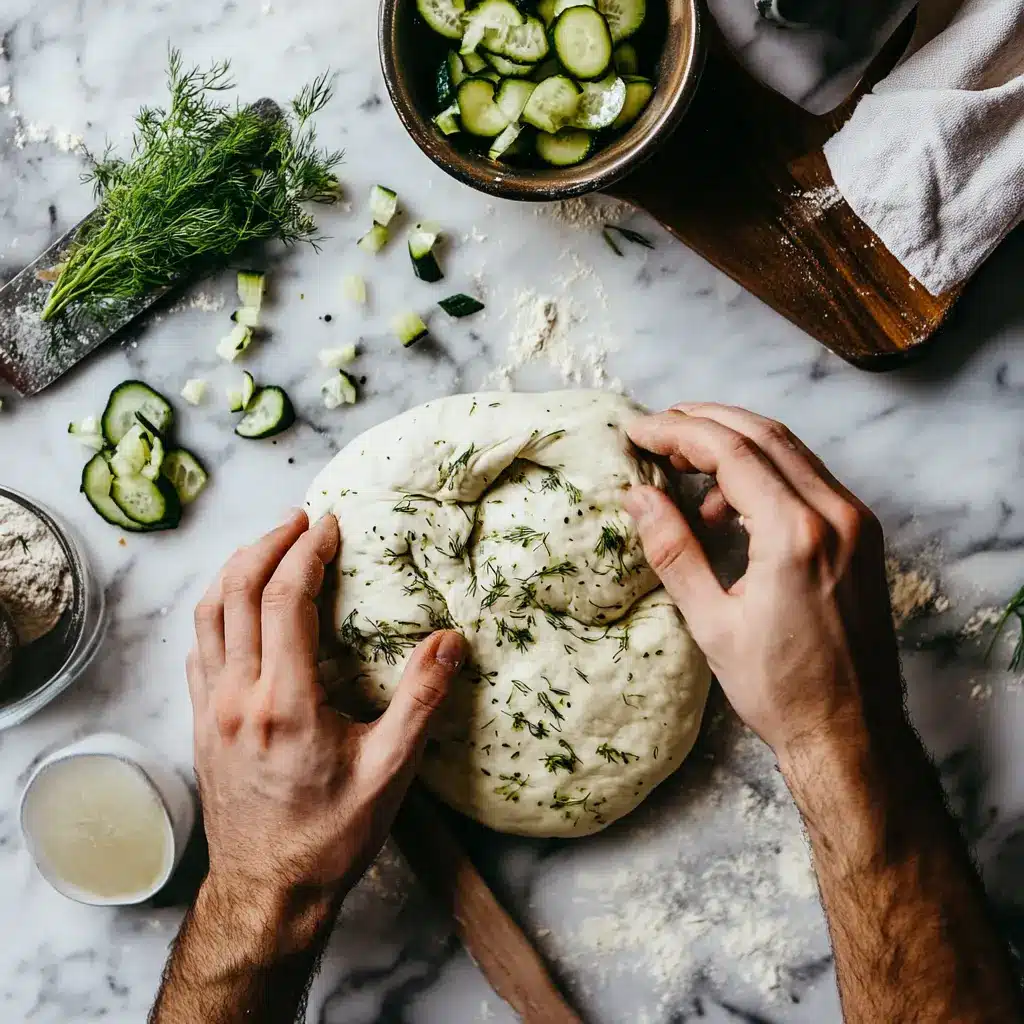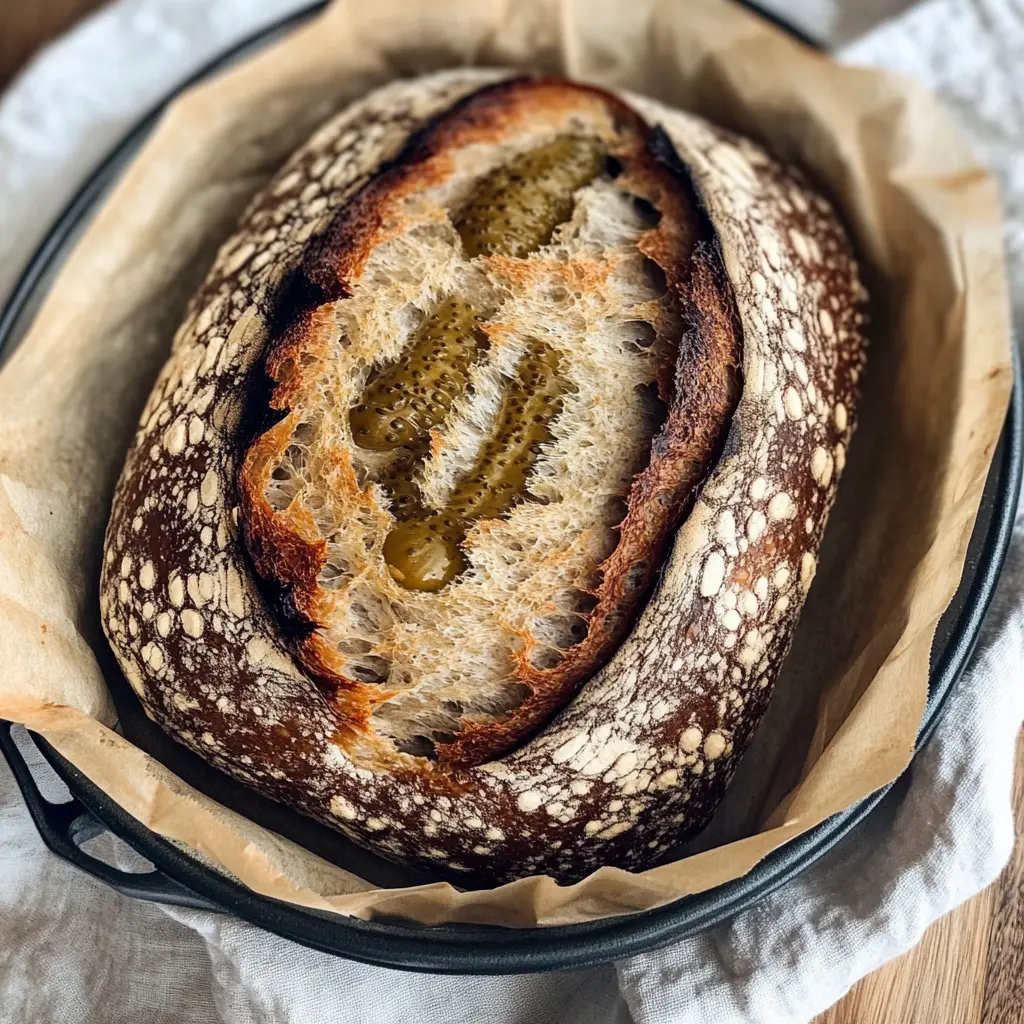Pickle Sourdough Rye Bread started as an experimental twist in our Dish RCP kitchen—born from a love of bold flavors, a passion for fermentation, and a question we couldn’t resist asking: what if we added pickle juice to our sourdough rye? The result wasn’t just edible. It was unforgettable.
At Dish RCP, we don’t just follow recipes—we explore flavor. Our founder, inspired by rustic Southern kitchens and the rise of creative sourdough baking, set out to create a bread that was both nostalgic and rebellious. This loaf brings together the deep, earthy richness of rye, the lively tang of a wild sourdough starter, and the unmistakable punch of dill pickle brine. Add a handful of finely chopped pickles, and you’ve got a savory artisan loaf that tells its own story—one slice at a time.
This recipe isn’t about trend-chasing. It’s about combining the old with the bold—something we strive for in every recipe we share. From its fermented heart to its crunchy crust, Pickle Sourdough Rye Bread reflects the soul of what we do at Dish RCP: creating comforting, accessible recipes that dare to be different.
Whether you’re already a sourdough pro or just getting your hands floured, this guide will walk you through every step. You’ll learn how to mix, fold, ferment, and bake this briny masterpiece—and why it might become your new favorite loaf.

Table of Contents
What Is Pickle Sourdough Rye Bread ?
A Flavor Revolution in a Loaf
Pickle Sourdough Rye Bread is a bold reinvention of traditional sourdough. Instead of relying solely on flour, water, and starter, this recipe swaps part of the water for acidic, herb-infused pickle juice. Then it folds in diced dill pickles during the stretching phase to lock in even more flavor and texture. The result? A crusty, chewy loaf with layers of tang and umami.
This isn’t your average sourdough. With its distinctive aroma and savory twist, it brings together the density of rye, the complexity of fermentation, and the sharpness of pickles for a completely new take on artisan bread.
The Ingredient Breakdown and How They Interact :Pickle Sourdough Rye Bread
Here’s how each component works in harmony:
- Rye Flour: Offers a hearty, earthy flavor and supports fermentation by breaking down easily for the natural yeasts.
- Pickle Juice: Replaces 200g of water, adding acidity that enhances fermentation and improves the crust’s color and crispness.
- Diced Dill Pickles: Introduced mid-process, these add moisture and bursts of herby tang throughout the crumb.
- Sourdough Starter: Acts as the natural leavening agent, creating air pockets and that familiar sourdough chew.
Together, they create a bread that’s rich, layered, and totally different from any rye or sourdough you’ve tried. Pickle Sourdough Rye Bread is proof that sometimes the strangest combinations make the most memorable meals.
Print
Pickle Sourdough Rye Bread
- Total Time: 4 hours 45 minutes
- Yield: 1 Large Loaf (8–10 slices) 1x
Description
Pickle sourdough rye bread packs a punch of tangy flavor with chopped cucumber dill pickles kneaded right into the dough, adding a bold twist to classic sourdough.
Ingredients
- 200 g Pickle Juice
- 170 g Water
- 50 g Active Sourdough Starter
- 350 g Bread Flour
- 50 g Whole Wheat Flour
- 100 g Rye Flour
- 3 g Salt
- 150 g Finely diced dill pickles
Instructions
1. Autolyse / Premix
Combine the sourdough starter, water, pickle juice, flours, and salt in a large mixing bowl. Stir with the handle of a wooden spoon until a shaggy, sticky dough comes together.
Cover the bowl with plastic wrap or a damp towel and let it rest at room temperature for 1 hour.
2. Initial Mixing & Forming the Dough
After autolyse, begin forming the dough by gently stretching and folding it. Reach under the dough, pull it up, and fold it over itself, turning the bowl as you go.
Repeat for 20–25 folds or until the dough forms a smooth, round shape. Cover again and let rest for 30 minutes.
3. Stretch & Folds (Incorporating Pickles)
Begin the stretch and fold process to build structure.
Complete the first set without any additions. On the second or third set, sprinkle in the diced dill pickles during the folding process. This helps distribute them evenly without tearing the dough.
Do a total of 4 stretch and fold sets, spacing each set 15 to 30 minutes apart. You can perform these folds directly in the bowl or on a lightly dampened surface—choose whichever is more comfortable for you.
4. Bulk Fermentation
After the final fold, cover the dough again and let it ferment at room temperature until it has visibly expanded and appears bubbly and airy. The duration will vary based on ambient temperature (refer to recipe notes for timing guidance).
5. Shaping
When bulk fermentation is complete, transfer the dough to a clean surface for shaping. Create surface tension by folding the dough into itself and shaping it into a batard or your preferred form.
Place the shaped dough into a floured banneton or lined proofing container.
6. Cold Fermentation
Loosely cover the banneton with a plastic bag or damp towel and place it in the refrigerator for a minimum of 5 hours, or up to 36 hours for deeper flavor and improved texture.
(Pro tip: reuse a large plastic bag to cover your dough.)
7. Prepping for Baking
Preheat your oven to 230°C / 450°F with a Dutch oven inside—allow it to heat for at least 1 hour to ensure it’s fully hot.
Keep your dough refrigerated until the moment you’re ready to bake. Cold dough placed into a hot Dutch oven produces excellent oven spring.
8. Baking the Pickle Sourdough
Carefully turn the dough out onto a piece of parchment paper. Score the surface with a lame, razor blade, or sharp knife.
Using the parchment as a sling, transfer the dough into the preheated Dutch oven. Optionally, mist the top with water for extra steam.
Cover and bake:
30 minutes with the lid on at 230°C / 450°F
10–15 minutes with the lid off at 210°C / 410°F to finish the crust
9. Cooling
Remove the bread from the Dutch oven and place it on a wire rack immediately. Let it cool completely before slicing for the best texture and flavor.
Notes
Equipment
- Mixing Bowl
- Banneton
- Dutch Oven
Sourdough Starter:
Make sure your starter is active and recently fed—bubbly and ready to rise dough.Stretch & Folds:
If doing folds on the counter, mist the surface with water instead of dusting with flour. The dough may be wet due to the rye and pickles but should still be manageable.Bulk Fermentation:
Fermentation time varies with room temperature. In a warm kitchen, it may finish in a few hours; in cooler settings, it might take overnight. Aim for dough that’s just doubled, soft, bubbly, and slightly wobbly. For long ferments in warm homes, reduce the starter amount (e.g., 25g) to slow things down.
Baking Tips:
Worried about a burnt bottom? Slide a baking tray under your Dutch oven. To finish baking the inside, turn off the oven, place the loaf directly on the rack, and leave the door slightly open for a slow finish. Always let your loaf cool for 4–6 hours before slicing.
- Prep Time: 4hours
- Cook Time: 45minutes
- Category: Baking, Side Dish, Sides
- Cuisine: American
Nutrition
- Calories: 1840kcal
- Sugar: 2g
- Sodium: 4181mg
- Fat: 9g
- Saturated Fat: 1g
- Carbohydrates: 380g
- Fiber: 26g
- Protein: 59g
Health Benefits of Pickle Sourdough Rye Bread
Is Pickle Sourdough Rye Bread Good for Your Health?
Let’s be real—most store-bought bread is loaded with preservatives, sugar, and highly processed flour. That’s why more people are turning to naturally fermented options like Pickle Sourdough Rye Bread. But does it actually offer health benefits, or is it just a flavorful trend?
Turns out, this loaf checks a lot of nutritional boxes.
The sourdough process gives the bread a lower glycemic index, which means it has less of an impact on your blood sugar levels compared to standard white or wheat bread. Fermentation also breaks down gluten and phytic acid, making nutrients like magnesium, zinc, and iron more available to your body.
And then there’s the rye flour. Known for being high in fiber and rich in antioxidants, rye promotes heart health, supports digestion, and keeps you full longer. When paired with wild sourdough fermentation, you’ve got a combo that goes beyond taste—it actually supports your well-being.
Here’s a quick look at why this bread stands out nutritionally:
| Nutritional Feature | Why It Matters |
|---|---|
| Natural Fermentation | Boosts gut health, improves mineral absorption |
| High in Fiber (Rye + Whole Wheat) | Aids digestion, promotes fullness |
| Low Glycemic Load | Helps stabilize blood sugar |
| No Artificial Ingredients | Cleaner eating, less inflammation |
| Probiotic Potential | Supports the microbiome when eaten fresh |
So yes, Pickle Sourdough Rye Bread isn’t just healthy—it’s one of the best bread choices you can make when baking at home.
Is It Anti-Inflammatory?
You’ve probably heard that fermented foods can help reduce inflammation—and that includes sourdough. But where does Pickle Sourdough Rye Bread stand on the anti-inflammatory scale?
The answer lies in the ingredients.
- Fermented Sourdough Starter: During fermentation, beneficial bacteria create lactic acid, which supports digestion and helps maintain a balanced gut—key to controlling inflammation.
- Rye Flour: This grain contains compounds like ferulic acid and lignans, which are linked to lower inflammatory responses in the body.
- Pickle Juice: It’s more than just flavor. The vinegar and herbs in pickle brine have mild antioxidant effects, and when combined with fermentation, they add to the loaf’s anti-inflammatory properties.
Unlike commercial breads made with refined flours and stabilizers, this loaf is clean, simple, and rooted in whole food ingredients. That alone makes it a smart option for anyone focused on reducing inflammation through food.
Why Add Pickle Juice to Sourdough?
How Pickle Juice Enhances Pickle Sourdough Rye Bread
One of the boldest moves you can make in artisan baking is to trade some of your dough’s water for something more flavorful—like pickle juice. In Pickle Sourdough Rye Bread, this switch doesn’t just add a funky twist; it transforms the whole character of the loaf.
Pickle juice brings three major benefits to the dough. First, it infuses the bread with bright, savory notes from garlic, dill, and vinegar. Second, the salt and acidity in the brine help condition the dough during fermentation. And third, it gives the bread a more dynamic taste without overwhelming the sourdough’s natural tang. You’ll notice that the crumb becomes slightly more open, the crust bakes darker, and every slice has that unexpected zip that keeps you coming back for more.
This isn’t just about flavor—it’s about balance and texture, too. Rye flour already adds density, but the juice helps lighten it up just enough. Together with sourdough starter, the dough becomes both sturdy and springy.

How Do You Add Pickle Juice to Sourdough Bread?
Adding pickle juice to your sourdough process is easier than you think. It’s all about replacing part of the total liquid in your recipe without changing the hydration level too much.
Here’s how to work it in:
- Measure Carefully
Start with 200 grams of pickle juice and 170 grams of water. This gives you a total of 370 grams of liquid—enough to keep the dough hydrated without making it slack. - Combine with Starter and Flours
Add the liquid mixture to your sourdough starter, then stir in your bread flour, whole wheat flour, and rye flour. Mix everything until the dough comes together. - Pause Before Kneading
Allow the dough to rest for around 60 minutes. This gives the flour time to soak up the brine and helps gluten begin forming naturally. - Mind the Dough Feel
If your dough feels loose or extra sticky, don’t panic. Pickle juice can soften the structure, but it will tighten up after stretching and folding. Stick to the recommended flour ratio unless it’s truly too wet to handle. - Pick the Right Pickles
Use high-quality dill pickle brine with clean ingredients—no artificial colors or sugar. That way, your Pickle Sourdough Rye Bread gets a clean, tangy flavor that doesn’t taste processed.
This briny trick isn’t just a gimmick. It adds complexity to your bread and enhances its fermentation profile naturally. If you’re ready to break the mold, this ingredient will do it—one flavorful fold at a time.
Understanding Rye’s Role in Fermentation
What Rye Flour Brings to Sourdough
When it comes to artisan bread like Pickle Sourdough Rye Bread, rye flour doesn’t just add variety—it actively enhances how your dough behaves. Unlike all-purpose or bread flour, rye contains a different set of proteins and enzymes that interact uniquely with wild fermentation.
Rather than focusing on strength, rye supports fermentation. Its composition encourages the sourdough culture to stay lively and balanced, even in cooler kitchens or longer proofing times. This makes rye a reliable flour for bakers looking to improve both structure and consistency.
With rye in the mix, expect a more grounded flavor and a hearty, compact texture. It’s ideal for sourdough because it naturally supports the microbes you want working in your dough.
Here’s what makes rye special:
| Rye’s Benefits | Effect on Sourdough |
|---|---|
| High enzyme activity | Boosts starter fermentation and gas production |
| Dense starch structure | Leads to a tighter, more moist crumb |
| Complex natural sugars | Enhances flavor depth in the final loaf |
| Strong mineral content | Supports starter health and activity over time |
Rye isn’t just filler—it’s fuel for fermentation. And in our pickle-infused version, it balances the sharper flavors from the brine perfectly.
How Rye Complements Pickle Juice and Sourdough
What’s especially interesting about Pickle Sourdough Rye Bread is how rye reacts to the addition of acidic pickle brine. Many flours slow down in low pH conditions, but rye actually performs well in this environment. The acidity doesn’t hinder it—it activates it.
Here’s how the ingredients team up:
- Rye is rich in sugars that sourdough starter thrives on, leading to a consistent and active fermentation.
- Pickle juice, naturally acidic, sets the stage for bold flavor while enhancing texture.
- Rye flour, instead of breaking down, stabilizes the dough and holds moisture well.
- The combination leads to a loaf with a firm crust, soft interior, and deep, savory notes.
The result is bread that feels rustic yet refined—hearty from the rye, tangy from the sourdough, and punchy from the pickles. You end up with something memorable, nourishing, and totally outside the ordinary.
Ingredient Breakdown and Nutritional Impact Pickle Sourdough Rye Bread
What’s Inside Pickle Sourdough Rye Bread ?
Every ingredient in Pickle Sourdough Rye Bread serves a purpose. This isn’t just a flavor experiment—it’s a recipe designed for both taste and nutrition. From the flour blend to the briny liquid and the fermented culture, each element contributes to the final loaf’s texture, structure, and health benefits.
Let’s take a closer look at what goes into this bold, hearty bread:
| Ingredient | Amount | Role in the Recipe |
|---|---|---|
| Pickle Juice | 200g | Adds acidity, flavor, and boosts fermentation with minerals and salt |
| Water | 170g | Combines with brine for dough hydration |
| Active Sourdough Starter | 50g | Natural leavening; promotes gut-friendly fermentation |
| Bread Flour | 350g | Provides strong gluten structure for rise and chew |
| Whole Wheat Flour | 50g | Adds nuttiness, fiber, and a denser texture |
| Rye Flour | 100g | Supports fermentation, increases flavor depth, and adds minerals |
| Salt | 3g | Strengthens gluten and balances flavor |
| Diced Dill Pickles | 150g | Introduces texture and concentrated savory dill flavor |
Together, these ingredients work harmoniously to produce a loaf that’s flavorful, tangy, chewy, and gut-friendly. The combination of flours ensures a hearty crumb, while the sourdough starter and brine make fermentation efficient and flavorful.
Nutritional Benefits of This Fermented Bread
What makes this loaf more than just a creative baking idea is its nutrient profile. Because it uses natural fermentation, whole grains, and brine instead of artificial flavoring, Pickle Sourdough Rye Bread offers nutritional advantages over standard loaves.
Key Health Benefits:
- Fermented Starter: Enhances digestion, promotes healthy gut flora, and lowers the bread’s glycemic impact
- Rye + Whole Wheat Flour: Rich in fiber, iron, and B vitamins; supports heart health and keeps you fuller longer
- Pickle Juice: Naturally high in electrolytes like sodium and potassium, which can support hydration
- No Commercial Yeast or Sugar: Keeps the recipe clean, with fewer inflammatory ingredients
- Lower Gluten Load: Due to sourdough fermentation and rye content, this loaf may be easier on sensitive stomachs
Plus, it’s incredibly satisfying. Unlike commercial sandwich bread that leaves you hungry an hour later, a slice of this rye sourdough can actually keep you going thanks to its higher fiber and complex carb content.
The Step-by-Step Baking Process Pickle Sourdough Rye Bread
How to Make Pickle Sourdough Rye Bread from Scratch
Making Pickle Sourdough Rye Bread may sound like a wild idea, but the process is actually straightforward once you break it into phases. This recipe depends on natural fermentation, slow proofing, and strategic folding—all designed to bring out the flavor and structure you want in a bold, tangy loaf.
Below, you’ll find an easy-to-follow guide that takes you from mixing to baking. Let’s dive in.
1. Mixing the Dough
Start by gathering your ingredients:
- 200g pickle juice
- 170g water
- 50g active sourdough starter
- 350g bread flour
- 50g whole wheat flour
- 100g rye flour
- 3g salt
Add the sourdough starter, pickle juice, water, and all flours into a large mixing bowl. Stir until everything is incorporated into a rough, sticky dough—no need to knead at this point.
Cover the bowl with a cloth or plastic wrap and let it rest for about an hour. This rest phase, often called the autolyse, gives the dough time to hydrate and begin developing gluten naturally.
2. Folding to Build Strength
After the resting phase, begin your first round of stretch and folds:
- Take one side of the dough, lift it gently, and fold it over the center.
- Turn the bowl and repeat this from all sides—about 4 or 5 folds total.
Let the dough sit for 30 minutes.
You’ll repeat this folding process four times, spacing each set 15–30 minutes apart. On the second or third fold, carefully add 150g of finely chopped dill pickles. Spread them across the top and fold them in until evenly distributed.
3. First Fermentation (Bulk Proof)
Once your folds are complete, let the dough ferment undisturbed. This bulk rise usually takes 4 to 6 hours, depending on your kitchen temperature. When ready, the dough should look aerated, soft, and slightly domed at the top.
4. Shape the Dough and Chill
Dust your work surface with flour and gently shape the dough into a round or oval, depending on your preference. Avoid over-handling the dough so you don’t deflate it.
Place the shaped dough into a well-floured proofing basket or a bowl lined with a cloth. Cover loosely, then refrigerate for a cold fermentation that lasts anywhere from 5 hours to 36 hours. The longer it rests in the cold, the more complex and flavorful the final bread will be.
5. Baking It Right
Preheat your oven to 450°F (230°C) with a Dutch oven inside. Allow at least 45–60 minutes of preheating to ensure it’s piping hot.
Take the dough straight from the fridge and place it onto parchment paper. Score the top with a bread lame or sharp knife to help the dough expand in the oven.
Using oven mitts, remove the Dutch oven, lower the dough into it using the parchment as a sling, cover it, and bake for:
- 30 minutes covered at 450°F
- Then 10–15 minutes uncovered at 410°F (210°C) to develop color and crunch
When finished, move the loaf onto a cooling rack and allow it to rest before cutting.
What to Expect From the Final Loaf
You’ll get a crusty exterior, soft interior, and beautiful bursts of dill pickle flavor throughout. Thanks to the rye and the pickle juice, the bread holds moisture well and delivers a complex, tangy, satisfying bite.
Flavor Profile & Texture Analysis For Pickle Sourdough Rye Bread
Tasting Pickle Sourdough Rye Bread: What to Expect
The moment you slice into Pickle Sourdough Rye Bread, you’ll notice it’s no ordinary loaf. It offers a layered flavor experience—sharp yet mellow, tangy yet savory. The aroma alone tells you something unique is coming. You’ll catch a whiff of dill, faint garlic, and sour notes wrapped in the warm, hearty scent of baked rye.
The flavor delivers exactly what the name promises. At first bite, you’re greeted with a subtle saltiness from the pickle brine, followed by the signature sourdough zing. The rye brings a rich, grounded quality that balances the brine’s bite. It’s not overwhelmingly “pickle-forward,” but every chew has that herbal edge you didn’t know you needed in bread.
There’s also a gentle nuttiness from the whole wheat and a slight vinegar brightness that lingers just enough. If you like bold bread, this one keeps every bite interesting.
Texture: The Perfect Harmony of Soft, Chewy, and Crunchy
This loaf doesn’t just taste good—it feels great in your hands and on your tongue. The Pickle Sourdough Rye Bread delivers a wonderful contrast between its crisp exterior and its pillowy interior.
Here’s how the texture stands out:
- Crust: Thin but firm, with a crackly finish from steam baking in a Dutch oven
- Interior: Dense but never dry; soft and springy thanks to the long cold proof
- Chew: Just enough resistance to make it satisfying—great for toasting or sandwiches
- Pickle Distribution: Chopped pickles add pockets of briny moisture and occasional crunch
- Moisture Level: Higher than average sourdoughs, due to the combination of brine and rye holding hydration
The texture is ideal for slicing thick or thin. It holds up well under spreads, melts, or even piled-high toppings. It’s hearty without feeling heavy and flavorful without needing much added.

Pro Tips for Success
Make Your Pickle Sourdough Rye Bread Foolproof
Creating the perfect Pickle Sourdough Rye Bread isn’t about fancy equipment or advanced techniques—it’s about fine-tuning the process. With ingredients like pickle juice and rye flour in the mix, getting the texture and flavor just right takes some thoughtful handling.
Here’s a list of practical tips to help you master this bread and avoid the most common missteps.
1. Handle the Extra Liquid Smartly
Pickle juice brings extra moisture to the dough, which can make it seem harder to manage.
Tip: Don’t rush to fix a wet dough by adding flour. Instead, let the dough develop gradually. Use stretch-and-folds to strengthen the gluten network while maintaining the brine-enhanced flavor.
2. Choose Clean Pickle Ingredients
If the brine includes sugar, food dyes, or artificial flavors, it can interfere with both taste and fermentation.
Tip: Stick with natural dill pickles that list basic ingredients—water, vinegar, salt, garlic, and dill. That way, the bread stays balanced and bakes clean.
3. Time the Pickle Add-In Carefully
Mixing in the pickles too early can cause the dough to tear or become uneven.
Tip: Add the chopped pickles during your second or third fold. This gives the dough time to strengthen and reduces the risk of overhandling.
4. Keep Your Starter Strong
Because there’s no commercial yeast here, your sourdough culture needs to be in peak condition to do the heavy lifting.
Tip: Feed your starter ahead of time, and make sure it’s lively and active—look for visible bubbles and a pleasant, tangy aroma. You want it rising well before you use it in your dough.
5. Let Time Do the Flavor Work
Rushing the fermentation limits both structure and taste.
Tip: After shaping, let your dough rest in the refrigerator for at least several hours. This slow chill deepens flavor and gives your bread more character—and a better crust.
6. Lock in Steam for a Killer Crust
Without steam, your bread can bake flat and pale.
Tip: Use a heavy lidded pot like a Dutch oven to create a steamy environment during the first half of the bake. The result is a crisp, caramelized outer layer and a nice open crumb.
Perfecting Pickle Sourdough Rye Bread takes more attention to rhythm than complexity. Once you get a feel for how this dough moves and reacts, everything else becomes second nature. Small details—like timing, temperature, and how you fold—can mean the difference between an average loaf and one that steals the spotlight.
Serving Ideas & Pairings
How to Serve Pickle Sourdough Rye Bread Creatively
Now that your Pickle Sourdough Rye Bread has cooled and your kitchen smells like pure magic, it’s time to enjoy it. With its punchy flavor, this bread isn’t your basic slice-and-butter situation—though that works too. Thanks to its herby brine and rye richness, it plays well with bold, creamy, and zesty combinations.
Here are several distinctive ways to savor every bite, from breakfast to dinner—and even snack hour.
1. Sandwiches That Actually Taste Different
This isn’t soft white bread—it’s bold, flavorful, and strong enough to carry stacked fillings without going soggy. Try it with ingredients that can match its personality.
Ideas to explore:
- Toasted with Swiss cheese, caramelized onions, and mustard
- Stacked with turkey, pickled jalapeños, and avocado mash
- Layered with eggs, arugula, and peppery yogurt spread
2. Toast That Isn’t Boring
Toasting really brings out the vinegar and dill notes. Go savory, go sweet, or get creative. The crust crisps up beautifully while the inside stays chewy and satisfying.
Toppings to try:
- Crushed white beans with chili oil and garlic
- Sliced radish and salted butter
- Ricotta with cracked pepper and citrus zest
- Dill cream cheese with cucumbers and lemon drizzle
3. Rustic Side for Hearty Dishes
Serve this bread next to warm bowls or saucy mains. The robust flavor makes it more than just a side—it becomes part of the dish.
Great with:
- Hearty lentil stew with lemon
- Smoky tomato and garlic soup
- Chickpea curry with fresh herbs
- Roasted vegetable bowls with tahini
4. Bread Boards and Appetizers
Pickle Sourdough Rye Bread turns an ordinary charcuterie spread into a conversation starter. Its tangy notes contrast beautifully with creamy or salty snacks.
Use it for:
- Mini toasts topped with whipped feta and roasted grapes
- Breadsticks or slices with olive tapenade
- Dipping with infused oils or spiced hummus
- Pairing with aged cheese and briny olives
5. Minimalist, but Never Boring
Sometimes, less really is more. With this much flavor baked in, you don’t need much to enjoy it.
Simple ideas:
- Warmed up with unsalted butter and flaky salt
- Brushed with olive oil and fresh cracked pepper
- Served with plain Greek yogurt and herbs as a dipper
No matter how you plate it, Pickle Sourdough Rye Bread always holds its own. It’s bold, balanced, and makes every topping—from the simplest butter to the richest spread—taste a little more exciting.
Conclusion: Briny, Bold, and Perfectly Fermented
Pickle Sourdough Rye Bread is more than a recipe—it’s a bold reimagining of what homemade bread can be. By combining the rich fermentation of sourdough, the hearty nutrition of rye, and the punchy flavor of dill pickles, this loaf stands out for both its taste and health benefits.
Whether you’re looking to level up your baking routine or just want something different to share at your table, this recipe offers the perfect balance of creativity, nutrition, and flavor. From the chewy, brine-kissed crumb to the crispy golden crust, every slice tells a story of tradition blended with experimentation.
If you’ve followed this guide, you now have the tools to create a loaf that’s unique, flavorful, and deeply satisfying. And if you’re ready to try more variations, there are endless ways to keep exploring sourdough creativity.
For recipes follow my pinterest
FAQs About Pickle Sourdough Rye Bread
How do you add pickle juice to sourdough bread?
To incorporate pickle juice into sourdough bread, simply substitute part of your water content with the brine. In most recipes like Pickle Sourdough Rye Bread, about 200g of pickle juice replaces an equal amount of water. Blend it with the rest of your hydration and mix it directly into the dough. This adds both flavor and acidity, helping fermentation and enhancing crust color.
Is sourdough rye bread the healthiest bread?
Sourdough rye bread is considered one of the healthiest bread options due to its whole grain content and natural fermentation. Rye is packed with fiber, vitamins, and minerals, while sourdough’s long fermentation improves digestibility and nutrient absorption. When combined in Pickle Sourdough Rye Bread, you get a loaf that’s not just flavorful but also great for gut health and blood sugar control.
What does rye do to sourdough?
Rye flour boosts sourdough fermentation by providing easy-to-access sugars for the starter’s wild yeast and bacteria. It creates a denser texture, adds a deep, earthy flavor, and helps keep the bread moist. In Pickle Sourdough Rye Bread, rye also balances the tang of the pickle brine and supports a more active, stable rise.
Is sourdough rye bread anti-inflammatory?
Yes, sourdough rye bread can offer anti-inflammatory benefits. The fermentation process promotes good gut bacteria, while rye contains polyphenols and antioxidants that reduce inflammation. With no added sugar and minimal processing, Pickle Sourdough Rye Bread can be a better choice for those looking to eat anti-inflammatory foods.
